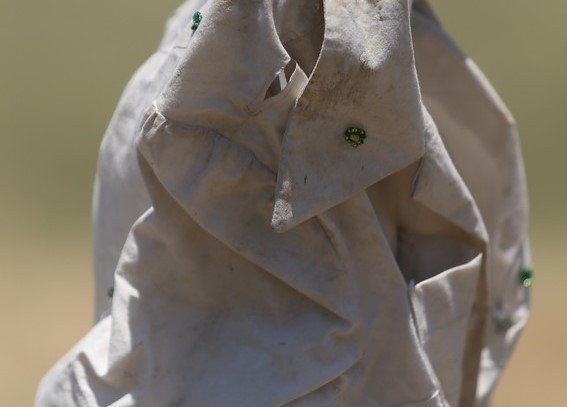Mother/Daughter/Sister/Saint
My Grandmother was an extremely devout woman who insisted my sister and I complete Confirmation classes in our church. My single distinct memory of that experience was the profound disappointment I felt learning that as Lutherans, we did not believe in the Saints. Only the Catholics get to have Saints. I was a far more devout student of the history of art than any organized religion, and through my study of art history, I was able to research the Saints and their attributes with abandon. One of my favorite books on the subject is by Agnes Baillie Cunningham Dunbar … her initials alone made investigating A Dictionary of Saintly Women a must. Her compilation is exhaustive, addressing the origin stories of Saints both well-known and highly obscure. From this two-volume tome published in 1904, I learned that there was not one St. Anna, but over thirty, each with her own story.
My fascination with the Saints explains why one of the first works of original art I ever bought was a painted wooden diptych by Brian Andreas that combined images with text; it queries if the “purple haired girl panhandling outside a motel” was, in fact, the Madonna. That idea has always stayed with me … the idea of being surrounded by Saints … would we recognize them without their halos and robes? What if that panhandler was the incarnation of Saint Lydia Purpuraria, the patron Saint of dyers, her customary purple shawl now replaced with a far more modern way to illustrate her tell-tale attribute?
When my Grandmother passed away, I found myself with boxes and boxes of old photographs. The image of my Great-Great Grandmother holding my Aunt as an infant, flanked by my Grandmother and Great Grandmother has always been a favorite; its simplicity and the direct gaze of the participants, none of whom are really smiling, always reminded me of icons featuring the Throne of Wisdom – the Madonna and Child –bordered by Saints. I pinned the photograph up in my studio and look at it often. It occurred to me that these women are my history and yet I know little about them beyond their role in my life as caregivers. Their thoughts and lives are known to me only through the scant stories that have been remembered and shared; despite being linked by name and blood, these women are as distant and unknowable to me as historical icons or saints.
In Dubar’s text, I looked up the stories associated with the names Anna, my maternal Great Grandmother; Mildred, my maternal Grandmother; and my paternal Grandmother, Lucille. The stories of their namesake Saints echoed my memories of them, their interests, and antidotes I remembered about their lives. I experienced the no-nonsense rigor of my Grandmother, who approached all facets of her life with grit and tenacity. It was she who taught me to sew and embroider. Thus, it seemed most fitting on the dress I sewed for her to embroider a quote about Saint Mildred in its border, something I could imagine her doing. As noted by Dunbar, “it happened that the bell-ringer fell asleep before the altar. The departed Mildred awoke him with a box on the ear, claiming ‘This is the oratory, not the dormitory!’” The dress is transparent, and the handcrafted dress form below the dress is covered in historical images of people considered freaks and misfits by society; Saint Mildred is noted for her generosity to the poor and social outcasts. My Grandmother worked for many years as a house mother at a home for so-called “wayward girls,” young women who were pregnant, had special needs, or emotional issues, and were wards of the state of Kansas. My Grandmother was stern, but could be tender, loving, and patient … the countless letters, photos and notes these young women sent to my Gram, years after leaving her care, speaks to the kindness that she showed those she loved.
Each one of the three women I chose to represent is clad in the same dress I sewed using a pattern from the 1940s and mimics the dress worn by my Great-Grandmother Anna, standing at the left. According to the stories my Mother shared, my Great-Grandmother’s no nonsense attitude was the reason for my Grandmother’s stern nature. Anna was a hardworking, pious woman who was known for helping others in the small community in which she was born, lived, and died in Nebraska. Saint Anna is the mother of the Virgin Mary and is considered to be the symbol of perfect motherhood; in Italian, she is known as “la vecchia potente” or the powerful old woman. I screened an image of three birds onto muslin to create the pattern on her dress, a direct reference to the many years Saint Anna was barren, once remarking (at least according to the collected tales of Ms. Dunbar) “the very birds in the trees have their children, but I have none.” Pregnant women are said to invoke her protection by wearing an apron or other clothing with brilliant emerald green, hence the eyes of the birds. Every story I remember being told about my Great-Grandmother made her seem to me as the embodiment of the powerful old woman, the grand matriarch of my family.
The woman I know the least about is my Paternal Grandmother, Lucille, who is not pictured. My memories of her are few; she was a small, slight woman, very different from the robust women on my mother’s side of the family. When I think of her, I see her pointy rimmed glasses and the trail of smoke from the cigarette that hung constantly from her lip, despite my Father’s severe asthma. The name Lucille has numerous variants, including Lucia and Lucy, and although lucia means light, the origins of Saint Lucy are less lucid and clear, just like my memories of my Paternal Grandmother. Of the variations in the more than twenty stories recorded by Dunbar, two consistencies emerge. The first, that Lucy, betrayed to the Romans as a Christian is to be burned at the stake, but her faith renders her inflammable, and she dies only after being stabbed through the throat; the second, that her eyes are removed. “The Lord gave her a new pair of eyes to reward her virtue, and she ever after carried the others in her hand,” thus explaining why images of Saint Lucy show her holding eyes in her hands. These consistencies resonated with my experiences of my Grandmother Lucille, who always seemed sharp in her comments, ever critical of my Mother. With this dress, I experimented with a variety of materials to create the sense of burning fabric, covering the mannequin on which the dress is displayed with pages from a book in braille.
I started this project with sketches and notes sometime in 2006. Both Mildred and Anna’s dresses traveled with me to places like Mexico and Turkey as I embroidered and stitched the details on each. The dresses were displayed for the first time in 2015 in a gallery in Reading, Pennsylvania but it was always my intent to have the pieces installed in Campbell, Nebraska at the site where the original photograph was taken. The land is no longer owned by my family; the house and surrounding buildings gone. Even the root cellar has been filled in to ensure the welfare of the cows that now use the land to graze. The man I know as “Uncle Bob” is my Grandmother’s cousin; he still lives close by and remembers when the area was inhabited by our extended family and their farms. Through his contacts and those of his daughter, Penny, we were allowed to install “the ladies” where the house in which both my Grandmother and Mother were born. The installation took place on November 26th, 2021. Penny is both a writer and photographer. She has graciously and enthusiastically also taken on the role of on-site facilitator, driving out to check on the ladies with my Uncle Bob and sharing updates. Her family made the installation possible, and all photos are thanks to her.
The road leading to the ladies is a minimum maintenance road, impassible during storms or snow. The graves of Mildred and Anna sit a few miles away. These women were not saints in the strict sense of the word, but their devotion to family and their stewardship of this land was sincere, reverent, and unwavering. I believe the ladies appreciate the quiet isolation, enjoying the ability to witness the seasons shift from fall to winter, spring to summer, directly connected to the land on which they lived. This project has spanned many years, providing me with a sense of peace and fulfilling my desire to know more about the women responsible for my being. It has also provided me with a newfound sense of belonging and connection to other family members for which I am so very grateful.
On November 16th, 2022, Penny and Bob drove to check on the installation. The weather over the past months, combined with more recent storms and winds proved to be too much for my dear ladies. They determined it was best to dismantle the installation lest the dresses be destroyed or go missing. Although disappointed that the ladies were unable to stay longer, as my goal was for the works to remain for the entirety of a year, I appreciate their wisdom in saving the dresses. Each shows the effects of their year at the homestead. Bits and pieces are torn and missing, and in spots, various insects made their home; each still smells of the prairie. I examined each dress closely as I worked to mount the pieces, wishing that they, like the women for whom they were made, could answer my many questions of what they experienced, saw, and felt. They now inhabit space in my studio, next to the photograph that inspired the project.
















































































































